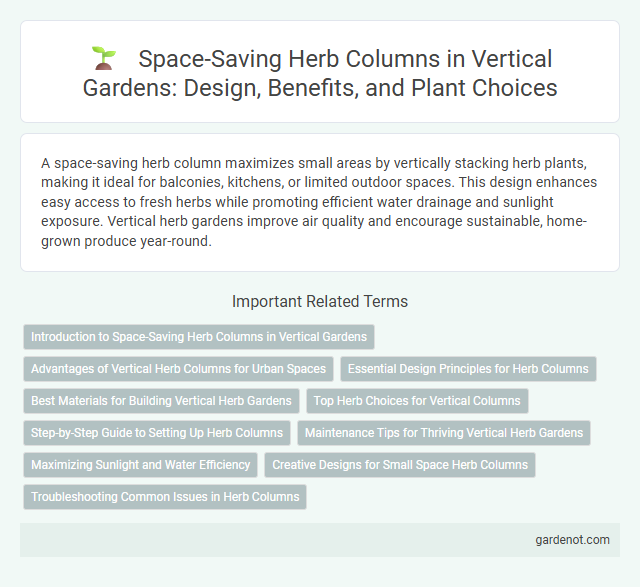A space-saving herb column maximizes small areas by vertically stacking herb plants, making it ideal for balconies, kitchens, or limited outdoor spaces. This design enhances easy access to fresh herbs while promoting efficient water drainage and sunlight exposure. Vertical herb gardens improve air quality and encourage sustainable, home-grown produce year-round.
Introduction to Space-Saving Herb Columns in Vertical Gardens
Space-saving herb columns in vertical gardens maximize limited space by stacking multiple herb plants vertically, allowing gardeners to grow a variety of herbs in a compact footprint. These columns optimize sunlight exposure and airflow for each plant, enhancing growth and yield in urban or small garden settings. Ideal for balconies, patios, and indoor environments, herb columns combine functionality with aesthetic appeal, making fresh herbs accessible year-round.
Advantages of Vertical Herb Columns for Urban Spaces
Vertical herb columns maximize limited urban space by allowing multiple herbs to grow upward rather than outward, making them ideal for balconies and small patios. These columns improve air quality and enhance urban biodiversity while providing fresh, homegrown herbs year-round. Their modular design and efficient watering systems reduce maintenance time and water consumption, offering a sustainable gardening solution for city dwellers.
Essential Design Principles for Herb Columns
Space-saving herb columns maximize vertical space by integrating modular, tiered planting units that ensure optimal light exposure and efficient water drainage. Essential design principles include selecting lightweight, durable materials resistant to moisture, incorporating ergonomic access for routine maintenance, and ensuring adequate airflow to prevent mold growth. Strategic placement and compact root systems further enhance plant health while maintaining a minimalist footprint in limited spaces.
Best Materials for Building Vertical Herb Gardens
Choosing the best materials for a space-saving herb column ensures durability, optimal plant growth, and ease of maintenance. Lightweight, weather-resistant options like cedar wood, recycled plastic, and galvanized steel provide excellent structural support while preventing rot and corrosion. Incorporating breathable fabric pockets or modular stackable containers enhances airflow and root health in compact vertical herb gardens.
Top Herb Choices for Vertical Columns
Basil, mint, and parsley are ideal herbs for space-saving vertical garden columns due to their compact growth habits and frequent culinary use. These top herb choices thrive in vertical arrangements, maximizing limited space while ensuring easy access for fresh harvests. Their adaptability to vertical planters promotes healthy root development and efficient nutrient uptake in confined environments.
Step-by-Step Guide to Setting Up Herb Columns
Create a space-saving herb column by selecting a sturdy vertical planter with multiple pockets or tiers. Start by filling each pocket with high-quality potting soil, ensuring proper drainage, then plant herbs like basil, thyme, and mint according to their sunlight and water needs. Regularly water and fertilize the herbs while rotating the column for even light exposure to promote healthy, compact growth in limited spaces.
Maintenance Tips for Thriving Vertical Herb Gardens
Space-saving herb columns thrive with consistent watering to keep soil evenly moist and prevent root rot. Regular pruning encourages bushier growth and prevents overcrowding, which optimizes light exposure for all plants. Using high-quality, well-draining potting mix and applying balanced liquid fertilizer every two weeks supports healthy, vigorous herbs in vertical garden columns.
Maximizing Sunlight and Water Efficiency
A space-saving herb column maximizes sunlight exposure by positioning plants vertically to capture optimal natural light throughout the day. Integrated drip irrigation systems minimize water waste by delivering moisture directly to the roots, enhancing water efficiency. This design supports healthy growth while conserving space and resources in urban gardens.
Creative Designs for Small Space Herb Columns
Space-saving herb columns efficiently utilize vertical areas by integrating modular pockets and tiered planting systems that maximize growth in limited spaces. Creative designs incorporate lightweight materials such as recycled plastic or felt, offering flexibility and easy maintenance while enhancing aesthetic appeal. These innovative herb columns often feature self-watering mechanisms and customizable configurations, ideal for balconies, kitchens, or urban apartments with minimal square footage.
Troubleshooting Common Issues in Herb Columns
Herb columns often face challenges such as inconsistent watering, poor drainage, and pest infestations, which can hinder plant growth and health. Regularly checking moisture levels, ensuring adequate drainage holes, and using natural pest repellents like neem oil can effectively address these issues. Proper maintenance and attention to these common problems help sustain a thriving, space-saving vertical herb garden.
Space-saving herb column Infographic

 gardenot.com
gardenot.com